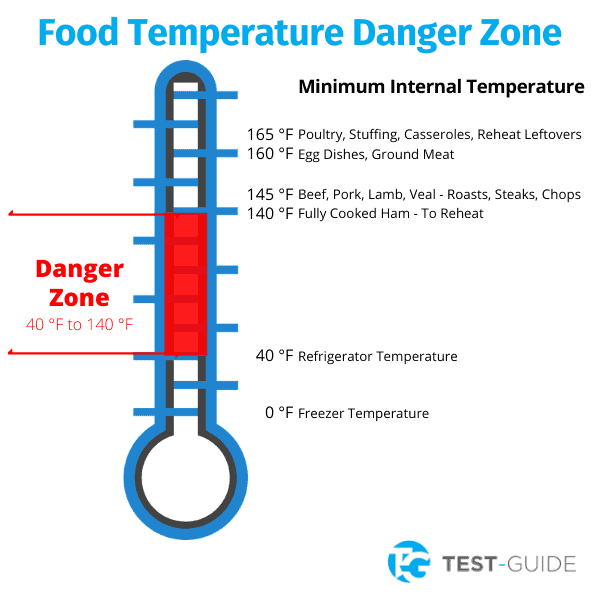Maintaining food within a safe temperature zone is important for many reasons and, simple to do with just a bit of knowledge. Keeping food in a safe temperature zone protects the end-user/eater from potentially harmful health effects (i.e. foodborne illness); it also allows one to remain compliant with the federal or state health inspection standards.
A restaurant worker or owner is tasked with the responsibility of maintaining the food being served in a safe temperature zone. The narrative that follows explains the ways in which to keep food out of the temperature danger zone.
What is the Temperature Danger Zone?
The Food Danger Zone (40°F – 140° F)
Food left at room temperature for too long becomes a breeding ground, a place for bacteria to grow to dangerous levels eventually becoming harmful (and dangerous) to the public. This is the Food Danger Zone.
Examples of common bacteria strains that grow at room temperature include –
- Escherichia coli [E-coli] – typically lives in everyone’s intestines. Most strains of E-coli are helpful to digestion; however, some strains weaken the human condition by bouts of diarrhea.
- Staphylococcus aureus – this bacterium cause soft tissue, skin and abscesses. It also causes blood stream infections and joint issues.
- Salmonella Enteritidis – symptoms include diarrhea and abdominal cramping that last four to seven days.
The Food Danger Zone is any temperature between 40+°F and 140°; this 120-degree range is the temperatures where bacteria grow fast and furious. Certain strains of bacteria, when left in a danger zone temperature can double in under twenty minutes.
It is noted that that food left in temperatures between 70 degrees and 125 degrees will have the most rapid growth of bacteria. And, the longer the food sits with the dangerous food zone, the greater the risk of bacterial growth in the food. When bacteria reach dangerous and unsafe levels, food spoils and it becomes harmful, even dangerous to eat.
Foodservice professionals are tasked with the responsibility of keeping food safe to eat. Many states require their food handlers to be certified by ServSafe or other certification agencies. The methods to keep food safe are discussed below.
How to Safely Handle Food
How Long Can Food Stay in the Temperature Danger Zone?
As a general rule, it is recommended that food be left out for NO MORE than 120 minutes. Remember, the safe temperature levels are–
- Cold Foods – Cold foods are safe at or (below) 40 degrees Fahrenheit.
- Hot Foods – Hot foods are safe when kept at a temperature above 140 degrees Fahrenheit.
It is important to note that food left out in a warm kitchen (90+ degrees) should only be left out for an hour, or less. The higher temperatures reduce the two-hour time window to only one. Warm or hot kitchens give are harmful bacteria growth a head start!
To challenege yourself on similar questions, review our free ServSafe practice questions.
How to Keep Food Out of the Temperature Danger Zone
The simplest way to keep food away from the temperature danger zone is to regularly monitor its temperature. When you know the temperature, you know exactly what to do. The Temperature Control for Safety (TCS) directives note that its written rules apply to a) when cooking and preparing food and food products, and b) when holding the different types of food at a buffet or a salad bar. The follow list details a few industry insights regarding the dangers of the food temperature danger zone –
- Consistently monitor the temperatures of the freezer and the refrigerator.
- Use a backup thermometer to ensure the built-in thermometer is accurate.
- Record the time and temperature in an ongoing log; you might need it in the future. This is important.
- Professionally maintain your thermometer by properly cleaning and calibrating the instrument according to the manufacturer’s instructions.
How to Hold Hot & Cold Food
Once food has been cooked to its recommended internal temperature [This is discussed below based on the type of protein] or chilled below 40 degrees Fahrenheit, the food must now be maintained at a safe temperature level (i.e. on that is outside the temperature danger zone) up to, and until, the food is served.
Food storage and delivery situations vary, but each should be managed with the primary goal to keep food outside the food temperature danger zone until it is served. Consider these different food serving and delivery circumstances –
- Storing food for extended times, i.e. salad bar, or a hot buffet.
- Transporting food to a satellite, catered event. The transportation of food must comply with additional rules to keep food safe for consumption, i.e. insulated bags or food pan carriers.
- In an unusual location, i.e. beach, a sailboat, or underwater.
What are Safe Temperatures for a Salad Bar or a Refrigerator?
A refrigerator and a salad bar are required to be set at a temperature of 40 degrees Fahrenheit, or below, to block the growth of dangerous bacteria that can cause dangerous bacteria to be ingested by an unsuspecting dinner guest. This mandated temperature is especially important when holding foods susceptible to bacterial growth –
- Egg and egg products.
- Salad Dressings and certain oils.
- Yogurt.
- Cheese.
- Meat.
- Poultry.
- Seafood
How Often Should the Holding Temperature be checked?
Most food experts agree that the temperature of the food being held for serving is at least once every four hours. However, to remain on the cautious side, it is recommended to check the temperature every 2 hours. This allows for an early notice that corrective action is needed; which then ensures the food being served is safe to eat is free of bacterial contamination.
Managing Hot Foods Properly
How Do You Hold Hot Food?
The following list offers insightful tips and guidance on how to keep hot foods safe and out of the food temperature danger zone –
- Equipment that is designed to hold hot food has one objective – to hold the food at a steady temperature of 140 degrees Fahrenheit.
- It is best to cover food to a) keep contaminants out, and b) help maintain a steady appropriate temperature.
- It is helpful to stir often as it helps evenly distribute the heat throughout the food
- Buy the best thermometer you can afford (a lot is riding on an accurate reading) and have someone monitor food temperatures often.
- Get rid of food that has exposed to less than 140 degrees for more than 2 hours – it is potentially dangerous for human consumption.
- Foods being held should not be mixed with new prepared food. This helps reduce cross-contamination.
Managing Cold Foods Properly
How Do You Hold Cold Food Safe?
Here are some tips to help properly hold cold foods – to avoid danger zone –
- Ensure your cold-holding equipment is designed to keep foods at 41 degrees Fahrenheit or below.
- Food should not be placed on ice, except for shellfish, vegetables, and fruit. All other food will cause the potential of cross-contamination that leads to dangerous levels of bacterial growth.
- Keep food covered to protect from contaminants.
- Cold food may be held without refrigeration for up to 6 hours starting from the time it was removed from refrigeration at a temperature below 40 degrees, or below.
- Get rid of cold food that has reached 70+ degrees Fahrenheit, or higher.
How to Rapidly Cool Hot Foods?
Large caterers and restaurants use innovative techniques to create their signature dishes; this sometimes includes compartmentalizing a dish’s recipe and preparing ahead of time those components, which make that possible.
Maximizing profit is about managing kitchen time efficiently. When possible, large food preparers freeze portions of a dish to help better manage cooking time; it is essentially a time-saver.
When hot food needs to be cooled quickly, it is best to bring the food temperature to 40 degrees or below (from its maximum internal temperature) within two hours.
How to Safely Cook Food
Cooking Meat – Food Temperature Recommended Zones
Another important way to help prevent food from becoming dangerous is to understand the appropriate internal temperatures for many commonplace proteins. According to the United States Department of Health & Human Services (HHS), the following denotes its recommended internal food temperatures to prevent foodborne illness.
| Category – Food | Recommended Temperatures |
| Ground Meat – Beef, Veal, Pork, Lamb | 160 Degrees F |
| Ground Meat –Turkey, Chicken | 160 Degrees F |
| Fresh – Beef, Chops, Roasts | 145 Degrees F |
| Fresh – Turkey, Chicken | 165 Degrees F |
| Poultry | 165 Degrees F |
| Pork | 145 Degrees F |
| Eggs | Until Yolk & Whites are Firm |
| Leftovers & Casseroles | 165 Degrees F |
| Seafood | Depends on fish, shellfish |
Resting Time for Meats
It is vital for meat to rest after it has been removed from its heat’s source, before taking its internal temperature. During this rest time, temperatures will first continue to rise (for at least a short while) as the juice from the meat redistributes throughout.
This short rise in temperature is effective in killing harmful and dangerous bacteria, which furthers the task of keeping food safe. It is al about food safety.
The Federal Regulatory Compliance & Oversight – The US Department of Agriculture (FSIS)
The United States Department of Agriculture (USDA), Food Safety & Inspection (FSIS) provides comprehensive information to food manufacturers, producers and agricultural businesses and handlers to help them maintain compliance with federally defined regulations for their establishments.


